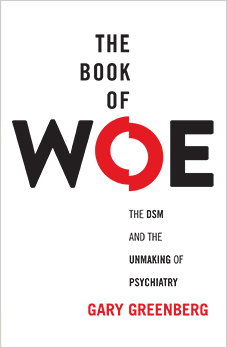David Kupfer, chair of the DSM-5 task force, shot back at Tom Insel, head of NIMH today with a statement that even by the standards Kupfer has set over the last five years is immensely obfuscating.
The promise of the science of mental disorders is great. In the future, we hope to be able to identify disorders using biological and genetic markers that provide precise diagnoses that can be delivered with complete reliability and validity. Yet this promise, which we have anticipated since the 1970s, remains disappointingly distant. We’ve been telling patients for several decades that we are waiting for biomarkers. We’re still waiting. In the absence of such major discoveries, it is clinical experience and evidence, as well as growing empirical research, that have advanced our understanding of disorders such as autism spectrum disorder, bipolar disorder, and schizophrenia.
Where to start? How about with that “we’re still waiting”? You’re still waiting? How about all the people whom you have diagnosed with what you insist are real illneesses (even if you acknowledge that they aren’t) caused by biochemical imblances (which you know don’t exist) and treated by drugs (whose mechanisms you don’t understand). They’re still waiting for your knowledge to catch up with your claims, and the idea that your clinical experience and empirical research somehow add up to more than a stopgap measure that is increasingly problematic, that has spawned a drugging of the population that is going to look to future historians like the lead contamination of the Roman water supply does to us–this idea is really beginning to wear thin.
But that;’s not the best part. The best part comes here–after the obligatory defense of DSM-5 as “the strongest system available,” leaving out the part about how it’s pretty much the only system available.
RDoC is a complementary endeavor to move us forward, and its results may someday culminate in the genetic and neuroscience breakthroughs that will revolutionize our field. In the meantime, should we merely hand patients another promissory note that something may happen sometime? Every day, we are dealing with impairment or tangible suffering, and we must respond. Our patients deserve no less.
RDoC is the NIMH initiative, harebrained in its own way, to find the neurocircuitry of psychopathology and develop a diagnostic system based on it. NIMH has a long time frame for RDoC, ten yeaqrs or so. But they’re not issuing any promissory notes, except maybe to congress to whom they are promising research results in return for appropriations. The people being asked to take psychiatry on faith are the patients, and the people soliciting the credit are psychiatrists, especially the psychiatrists of the APA. We still,they are saying, after 150 years, don’t know what a mental illness is, we gave up a long time ago on trying to figure it out, we can’t agree on how to identify the mental illnesses that we think might exist, we just spent $25 million to make a diagnostic manual that, by our own measure, is worse than the last one, and we can’t even articulate a decent defense of it that doesn’t sound like saying we know it’s a mutt but it’s our mutt and it protects our house and if it Biedermans on the floor or Nemeroffs on the carpet or once in a while Abilifies the neighbor’s cats, well, that’s just the cost of having us around, and so you should just trust us, and by the way if you don’t, then you either don’t care about the mentally ill or you are just an antipsychiatrist following Tom Cruise because he’s so cute.
I mean, if the DSM-5 ain’t a promissory note, then I don’t know what is. and like many promises issued by confidence men, it’s not worth the paper it’s printed on.















